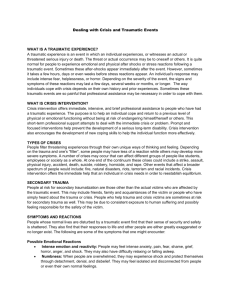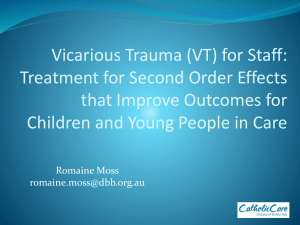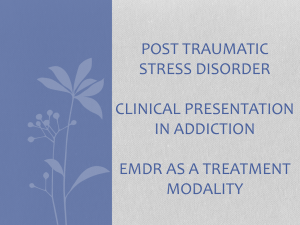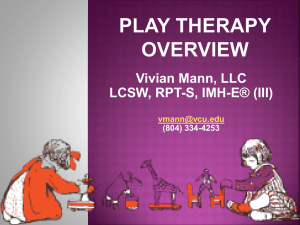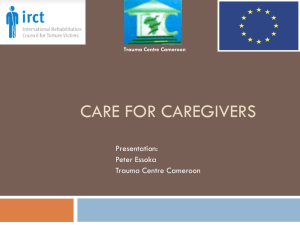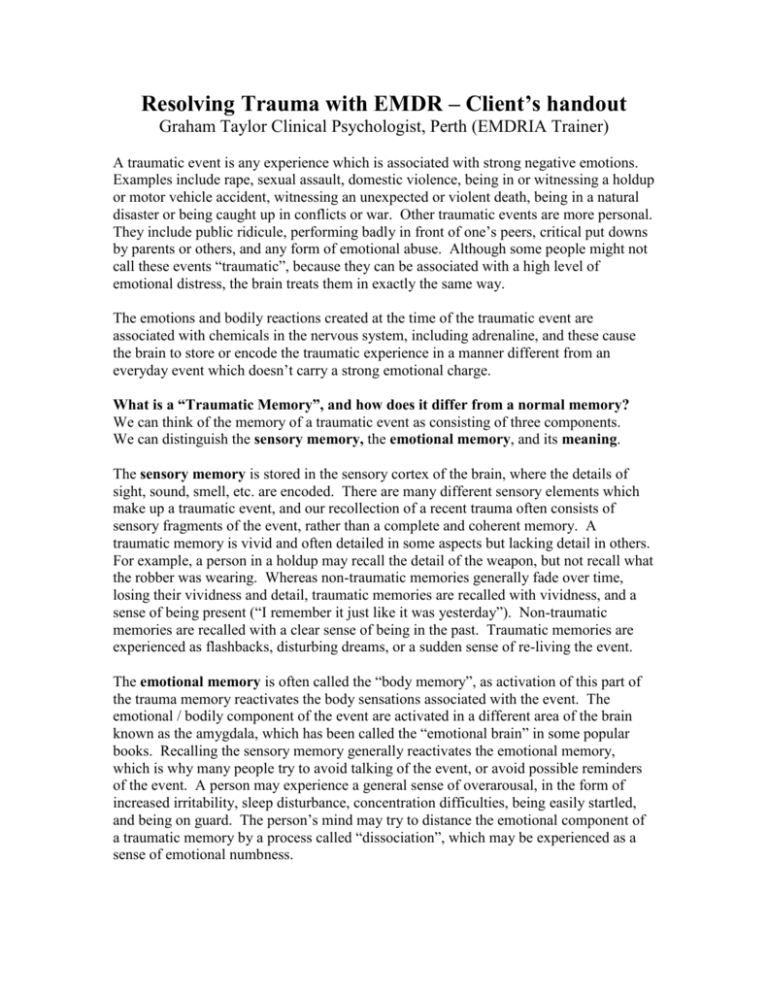
Resolving Trauma with EMDR – Client’s handout
Graham Taylor Clinical Psychologist, Perth (EMDRIA Trainer)
A traumatic event is any experience which is associated with strong negative emotions.
Examples include rape, sexual assault, domestic violence, being in or witnessing a holdup
or motor vehicle accident, witnessing an unexpected or violent death, being in a natural
disaster or being caught up in conflicts or war. Other traumatic events are more personal.
They include public ridicule, performing badly in front of one’s peers, critical put downs
by parents or others, and any form of emotional abuse. Although some people might not
call these events “traumatic”, because they can be associated with a high level of
emotional distress, the brain treats them in exactly the same way.
The emotions and bodily reactions created at the time of the traumatic event are
associated with chemicals in the nervous system, including adrenaline, and these cause
the brain to store or encode the traumatic experience in a manner different from an
everyday event which doesn’t carry a strong emotional charge.
What is a “Traumatic Memory”, and how does it differ from a normal memory?
We can think of the memory of a traumatic event as consisting of three components.
We can distinguish the sensory memory, the emotional memory, and its meaning.
The sensory memory is stored in the sensory cortex of the brain, where the details of
sight, sound, smell, etc. are encoded. There are many different sensory elements which
make up a traumatic event, and our recollection of a recent trauma often consists of
sensory fragments of the event, rather than a complete and coherent memory. A
traumatic memory is vivid and often detailed in some aspects but lacking detail in others.
For example, a person in a holdup may recall the detail of the weapon, but not recall what
the robber was wearing. Whereas non-traumatic memories generally fade over time,
losing their vividness and detail, traumatic memories are recalled with vividness, and a
sense of being present (“I remember it just like it was yesterday”). Non-traumatic
memories are recalled with a clear sense of being in the past. Traumatic memories are
experienced as flashbacks, disturbing dreams, or a sudden sense of re-living the event.
The emotional memory is often called the “body memory”, as activation of this part of
the trauma memory reactivates the body sensations associated with the event. The
emotional / bodily component of the event are activated in a different area of the brain
known as the amygdala, which has been called the “emotional brain” in some popular
books. Recalling the sensory memory generally reactivates the emotional memory,
which is why many people try to avoid talking of the event, or avoid possible reminders
of the event. A person may experience a general sense of overarousal, in the form of
increased irritability, sleep disturbance, concentration difficulties, being easily startled,
and being on guard. The person’s mind may try to distance the emotional component of
a traumatic memory by a process called “dissociation”, which may be experienced as a
sense of emotional numbness.
Some time after the trauma occurs the third component is formed in yet another part of
the brain, the prefrontal lobes. This third component of the traumatic memory is the
meaning that the event has for the person. These are not the thoughts we had at the time
of the trauma, it is the meaning that that event has afterwards. This is then applied to
other situations subsequent to the traumatic event, triggering emotional and behavioural
reactions long after the original traumatic event.
In the table below are examples of traumatic events, and their components.
Traumatic
Event
A motor vehicle
accident
Sexual Assault
Being criticised
in front of
colleagues
Sensory Memory
The sight of the
other vehicle filling the
windscreen a fraction
before impact
Being held down,
seeing the wild glare in
the attacker’s eyes,
the smell of alcohol on
his breath
Seeing everyone
staring at me, some
people are sniggering
Emotional/Body
Memory
Fear,
tensed
muscles,
knotted
stomach
Meaning
I’m not safe.
Terror, numbness
I’m helpless,
I can’t trust
men.
Shame,
embarrassment,
blushing and
sweating
I’m incompetent
and useless.
People think
I’m an idiot.
What happens when a trauma memory resolves?
Memories of trauma will often resolve over time. People talk of “getting over it” but just
what does this mean? Complete resolution involves changes in the three aspects of
trauma memory described above. As the trauma memory is resolved the sensory memory
becomes less detailed, less vivid and more distant. It loses its “in your face” quality and
becomes “just a memory”, rather than an experience which is continually relived.
As the sensory memory resolves so does the emotional or body memory. Recalling or
talking of the traumatic event no longer evokes a strong emotional charge. Present events
that are related to the original trauma no longer activate a significant emotional charge.
For example, if you were in a motor vehicle accident where a truck came through a Give
Way sign, you would know that the memory had resolved when intersections and trucks
no longer triggered a significant emotional or physical reaction.
The third aspect of the trauma memory is resolved when you have a useful perspective of
the event that feels true. For example, if you were a pharmacy assistant who was held up,
you would be able to recall the memory of the hold up, and at the same time think to
yourself: “It’s over, I did well, I can keep myself and others safe.” If these thoughts
FEEL right, if they have the ring of Emotional Truth, and are not just empty words, then
we can say that resolution has been achieved.
What about the situation when Resolution does not happen naturally?
Trauma memories may settle and resolve naturally over a few weeks, but for many
people they do not. When problems persist from the trauma the condition is known as
Post Traumatic Stress Disorder (PTSD). PTSD is a relatively new term, but the condition
is not new, and descriptions of this condition can be found in literature going back 2500
years. Some of the symptoms of PTSD include:
Recurring, distressing memories, while awake, or in dreams
Sudden flashbacks to the traumatic event
Distress triggered by reminders that link back to the traumatic event
Avoiding or attempting to avoid thoughts / feelings associated with the trauma
Avoiding activities / places / people which trigger recollections of the trauma
Diminished interest in normal activities
Emotionally distant
Less positive feelings
Pessimistic about the future
Sleep difficulties
Concentration difficulties
Increased irritability or anger
A sense of being on guard
Easily startled.
Summary of the differences between resolved and unresolved trauma memories.
UNRESOLVED
RESOLVED
The memory is detailed, vivid, “in your
The memory is less vivid and less detailed.
face”. It seems more recent then it actually It has lost its sense of immediacy. It has
is. Eg “I remember it just like it was
become a part of one’s history.
yesterday”. It may be relived through
“It happened”. Sleep is not disturbed, and
dreams or flashbacks.
flashbacks do not occur.
The memory continues to have a strong
The memory can be recalled or discussed
emotional charge when discussed or
without significant distress.
thought about.
Current events which have some element in Current events which have some element in
common with the trauma event will
common with the trauma event no longer
reactivate the memory and it’s distressing
reactivate the old memory and its
emotions. Patterns of avoiding situations
distressing emotions. A person no longer
or activities may develop as a result.
avoids normal situations or activities.
The person carries negative or unhelpful
The person can recall the traumatic event,
beliefs from the traumatic event into their
but also think and believe more positive
present life.
and useful thoughts about themselves in the
present.
Therapists help people resolve trauma by creating a safe environment in which the
experience of the traumatic event can be shared, and its meaning explored. Talking about
the trauma can be difficult initially, if the person often has tried to avoid the trauma
memory. While avoidance does help in the short term, much research has shown that it
can make the avoided memory even more distressing.
In the end, avoidance strategies are not helpful, and this has long been recognised. There
is an old African proverb that says, “You can outrun the lion that is chasing you. You
cannot outrun the lion in your head.” Trauma memories are like lions in your head.
EYE MOVEMENT DESENSITISATION & REPROCESSING
In 1989 a new therapy called Eye Movement Desensitisation and Reprocessing (EMDR)
was announced which claimed to rapidly resolve trauma memories, with greater speed
and effectiveness than other therapies used at the time. Studies have now demonstrated
that EMDR is more effective and efficient in resolving trauma compared with ANY other
psychological or psychiatric treatment, including medication.
During EMDR the client is guided to deliberately bring into conscious awareness the
sensory memory, their thoughts, and the accompanying emotions and bodily sensations.
Clients need to be willing to experience the emotions and body sensations that
accompany the recall of a distressing memory and associated thoughts.
Then by following the moving fingers of the therapist, the client’s eyes move rapidly for
a brief period, around 30 seconds. This produces a distinctive and naturally occurring
pattern of electrical activity in the brain, which causes the stored trauma memory to
quickly change. The exact mechanisms in the brain which cause the memory to change
have not yet been discovered, but the regions of the brain involved with sensory storage,
emotional activation and reasoning all become more active, with changed patterns of
nerve cell firing.
During the eye movement the therapist does not talk or offer suggestions. The client does
not try to change any aspect of the memory, and is asked to just notice the experience, to
observe their memory, emotions, bodily sensations and thoughts. At the end of each set
of eye movements the client is then asked to report their present experience. It may be
that the sensory memory becomes less detailed or less vivid, and clients often report that
the memory has become quite distant. Commonly the emotional or bodily sensations
reduce in intensity quite quickly. If other associations are observed, they are shared with
the therapist. Further sets of eye movement follow.
Once the trauma memory no longer triggers feelings of distress, the client is asked to
associate a more useful thought to the now more distant trauma memory, and further sets
of eye movements follow. The EMDR process is complete when the new perspective
feels true even when the old memory is recalled. This entire process may take as little as
ten minutes, or as long as a full session. Where there are several different experiences
underlying the client’s difficulties, it may take a number of sessions to fully resolve them.
EMDR is not suitable for all clients. Some clients need additional help in developing
skills in managing and reducing emotional arousal. Whilst EMDR looks simple, there
are many important procedural steps for the therapist to follow. It takes over 30 hours of
closely supervised training to fully train an EMDR therapist.
© 2003 Graham Taylor. All rights reserved.

